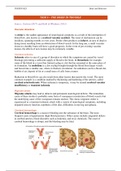PSY/IPN1023 Body and Behavior
TASK 9 – THE BRAIN IN TROUBLE
Source: Carlson (2017) and Kolb & Whishaw (2013)
Vascular disorders
A stroke is the sudden appearance of neurological symptoms as a result of the interruption of
blood flow, also known as a cerebral vascular accident. The onset of dysfunction can be
insidious, spanning months or even years. Stroke often produces an infarct, an area of dead or
dying tissue resulting from an obstruction of blood vessels. In the long run, a small vascular
lesion in a healthy brain will have a good prognosis. In the event of pre-existing vascular
lesions, the effects of new lesions may be extremely variable.
Cerebral ischemia
Ischemia refers to any of a group of disorders in which the symptoms are caused by vessel
blockage preventing a sufficient supply of blood to the brain. In thrombosis for example,
some of the blood in a vessel has formed a plug or clot that has remained at the same place of
its formation. An embolism is a clot or plug brought through the blood from larger vessels
and forced into a smaller one, where it obstructs circulation. An embolism can be a blood clot,
bubble of air, deposit of fat or a small mass of cells from a tumor.
Reduction in blood flow can also result from other factors that narrow the vessel. The most
common example is a condition marked by thickening and hardening of the arteries, called
cerebral arteriosclerosis. When ischemia is temporary, it may be termed cerebral vascular
insufficiency or transient ischemia.
Migraine stroke
Migraine attacks may lead to infarcts and permanent neurological deficits. The immediate
cause of these strokes is probably some form of vasospasm (constriction of blood vessels) but
the underlying cause of the vasospasm remains unclear. The classic migraine stroke is
experienced as a transient ischemic attack with a variety of neurological symptoms, including
impaired sensory function, numbness of the skin, difficulties in moving and aphasia.
Cerebral hemorrhage
Cerebral hemorrhage is a massive bleeding into the substance of the brain. The most
frequent cause is hypertension (high blood pressure). Other causes include congenital defects
in cerebral arteries, blood disorders such as leukemia, and toxic chemicals. The onset of
cerebral hemorrhage is abrupt, and the bleeding may be fatal.
, PSY/IPN1023 Body and Behavior
Angiomas and aneurysms
Angiomas are congenital collections of abnormal vessels that divert the
normal flow of blood (figure). These capillary, venous or arteriovenous
(A-V) malformations are masses of enlarged and torturous cortical vessels
that are supplied by one or more large arteries and are drained by one or
more large veins, most often in the field of the middle cerebral artery.
Because they create abnormalities in the amount and pattern of blood
flow, angiomas may lead to stroke or inadequate distribution of blood
flow.
Aneurysms are vascular dilations resulting from localized defects in the elasticity of a vessel.
They can be visualized as balloon-like expansions of vessels that are usually weak and prone
to rupture. Aneurysms are usually due to congenital defects, but may also develop from
hypertension, arteriosclerosis, embolisms or infections.
The treatment of vascular disorders
Most vascular disorders have no specific treatment, although the most common remedies
include drug therapy and surgery. They include such drugs as anticoagulants to dissolve clots
or prevent clotting, vasodilators to dilate the vessels, drugs to reduce blood pressure, and salty
solutions or steroids to reduce cerebral edema (accumulation of fluid in and around damaged
tissue).
Traumatic brain injuries
Traumatic brain injuries (TBIs) can affect brain function by causing direct damage to the
brain; by disrupting blood supply, by inducing bleeding, by causing swelling, by opening the
brain to infection and by producing the scarring of brain tissue. There are two main types of
brain trauma; open-head injury and closed-head injury.
Open-head injuries
Open-head injuries are TBIs in which the skull is penetrated, as in gunshot or missile
wounds, or in which fragments of bone penetrate the brain. In many cases, the injury does not
cause the victim to lose consciousness. They tend to prove distinctive symptoms that may
undergo rapid and spontaneous recovery. The neurological signs may be highly specific, and
the effects closely resemble the functions of a small area of cortex.
Closed-head injuries
◊ Damage at the site of the blow, a bruise (contusion) called a coup, is incurred where
the brain has been compacted by the bone’s pushing inward, even when the skull is
not fractured (figure).
◊ The pressure that produces the coup may push the brain against the opposite side or
end of the skull, producing an addition bruise, the countercoup (figure).
◊ The movement of the brain may cause a twisting or shearing of nerve fibers,
producing microscopic lesions. These lesions may be throughout the brain but are
most common in frontal and temporal lobes. In addition, twisting and shearing may
damage the major fiber tracts of the brain, especially the corpus callosum and anterior
commissure, which can ultimately lead to a disconnection syndrome.




